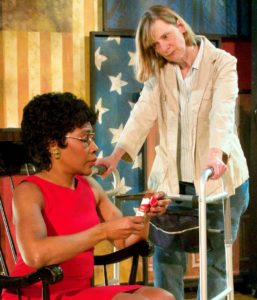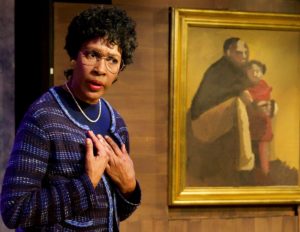
 Recommended *** Andrea Conway-Diaz transforms herself into former Congresswoman Barbara Jordan right before our eyes in Kristine Thatcher’s poignant bio-drama “Voice of Good Hope.” This memorable performance must be seen, if only to witness just how well Conway-Diaz captures Jordan’s voice, demeanor, subtleties of body language, and increasing disability.
Recommended *** Andrea Conway-Diaz transforms herself into former Congresswoman Barbara Jordan right before our eyes in Kristine Thatcher’s poignant bio-drama “Voice of Good Hope.” This memorable performance must be seen, if only to witness just how well Conway-Diaz captures Jordan’s voice, demeanor, subtleties of body language, and increasing disability.
Deep and cerebral, this is a story about a black woman who triumphs within a racist society despite so many odds against her. By means of college, force of personality, and sheer guts and determination, she finds her way from the isolation of the historically black Fifth Ward of Houston, Texas, to serving in the U.S. House of Representatives as the first black woman from Texas—and the South—to become a member of Congress. Her claim to fame on the national stage was gained through her important role on the House Judiciary Committee during the Nixon impeachment inquiry in 1973-74. Conscience and reason guided her service to the nation during times of division between white Southern Democrats (Dixiecrats) and black and liberal Dems from the North and urban areas.
The script ties together Jordan’s personal and professional relationships through a series of vignettes. Although the timeline constantly shifts, the story is easy to follow.
A young Barbara Jordan (MiKayla Boyd) is a bright young girl, who is initially treated as a troublemaker at school. But John Ed Patten (Jamie Black), a rag picker, teaches her a lot about life, specifically about unfairness and discrimination in the black community. “You’re wise, but not smart,” he tells her. In meaningful conversations with him, the dark-skinned Barbara asks the question: What does having a dark (or light) skin tone mean to others? What does it mean to have a black heart? Young Barbara struggles with the moral implications of color discrimination among the African-American children who are her peers. Herein, we see goodness as being the merging of the sacred and secular, such that religion does not have a monopoly on the truth or the spiritual.
The biography is thoughtful and deliberate. The light of Jordan’s strong character shines through Conway-Diaz’s powerful acting performance, paired up with crisp monologues and open-ended soliloquies. Supporting characters are largely foils for Jordan’s intensely reasoned arguments. Disagreements with Julie Dunn (Noelle Klyce) are used to point up Jordan’s opinions about racial integration, while disagreements with Robert Strauss (Paul Chakrin) allow her to show her underlying character: not to hold grudges with whites who have been racist and who have promoted racism in the past. Her message is that people can always change. We can see past distinctions of race and skin color. It was her belief that we are only one America—one nation, one culture—and we all have to get along. She strongly felt that racial segregation made people separate and unequal. She abhorred the notion of throwing out the whole system of laws and becoming two nations—one black and one white—because of past injustice and unfairness. Above all, she was worried that interest group politics would tear America apart so that we would not be one country anymore.
Problematic are scenes involving Nancy Earl (Susie Griffith), who is white, and refers to herself as Jordan’s housemate. The fact, however, is that she has been Jordan’s companion of thirty years. We never see any form of affection or intimacy or even playfulness between the two during the time Earl cares for Jordan throughout her unnamed infirmity: multiple sclerosis. Earl’s role in the play is largely to point up Jordan’s stubborn and willful independence in her personal relationships as well as in her professional ones. She is present to describe Jordan’s ailments to Dr. Karen Woodruff (Sahara Glasener-Boles), who fawns over her famous patient. This is a particularly contrived device that points up the climax of the story: that Jordan has attained national stature and has gained the respect of all people—black and white—by the time she is awarded the Presidential Medal of Freedom by President Bill Clinton in 1994.
The presentation largely works for those who like listening to speeches and who are already acquainted with Barbara Jordan and the causes she stood for, as opposed to a general audience. The story also plays to those predisposed to issues involving government and politics, if not those already sensitive to matters of race and race relations. Most importantly, the play relies, in large part, on memories of politically-interested people like myself, once glued to their television sets and hanging onto every word of the judiciary committee members. Twenty years after its writing, it is unclear whether the story can serve well enough as an introduction to the powerhouse that Barbara Jordan was to those of us who watched her in earnest during the Watergate hearings, saw her on television as the keynote speaker at the 1976 Democratic National Convention, and generally followed her career from the 1970s through the 1990s. In other words, younger attendees of “Voice of Good Hope” may not glean the significance of this tremendously vital woman from this one performance. The play thus raises the issue of reviving certain episodes in our political history without adequately explaining them to a modern audience.
Unlike shows that cloak themselves in singing, dancing, and glamor as a guise for examining social and political issues, “Voice of Good Hope” does not hide its morality through artistry or artfulness. Rather, Jordan’s biography is direct and forceful in its meaning and its implications for the future. Hers is the voice of good hope: It is the hope that rests in her unflagging belief that the nation’s future will be brighter than its past. Above all, it is a hope based on her intuitive sense that we as a people will attain greater inclusiveness. This is the same sense of hope that future President Barack Obama spoke about in his famed keynote speech during the 2004 Democratic National Convention, four years after this play was written, and twenty-eight years after Jordan had delivered a similar address about her vision of national unity.
Barbara Jordan died in 1996, but the power of her life and her oratory live on. Coincidentally, the night I watched the performance of “Voice of Good Hope”, House managers were arguing their case at President Donald J. Trump’s Senate impeachment trial. It was obvious that the audience could not help but make implicit comparisons between then and now, especially when it came to Jordan’s monologue about obstruction of justice on the part of the President and the need to uphold our laws and our Constitutional form of government. That said, at this very moment in time, Jordan’s biggest legacy has to do with the fact that so many talented people of color currently play such a pivotal role in the U.S. Congress and that a number of them are being represented as House Managers. Notwithstanding the politics of the current situation, this is, in fact, a tribute to the needle moving forward.
“Voice of Good Hope” is being presented by City Lit Theater and is directed by their artistic director and producer Terry McCabe. Kristine Thatcher is currently City Lit’s playwright-in-residence. Performances take place on the second floor of the Edgebrook Presbyterian Church, 1020 W. Bryn Mawr Avenue, Chicago, through February 23, 2020.
Tickets are $32, seniors $27, students and military $12 (all plus applicable fees)
The performance schedule is:
 Fridays and Saturdays – 7:30 p.m.
Fridays and Saturdays – 7:30 p.m.
Sundays – 3:00 p.m.
Mondays, February 10 and 17 – 7:30 p.m.
For more information, contact 773-293-3682 or info@citylit.org or visit www.citylit.org.
To see what others are saying, visit http://www.theatreinchicago.com go to Review Round-Up and click at “Voice of Good Hope”.







More Stories
“Guys & Dolls”
“The Music Man”
“The S Paradox” reviewed by Julia W. Rath